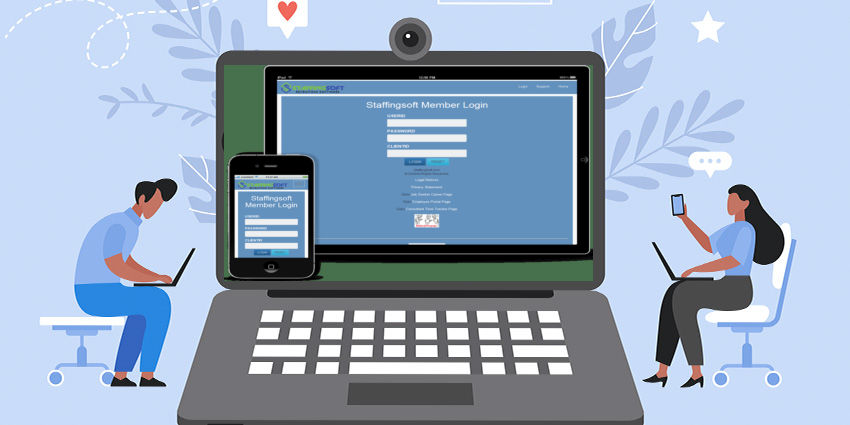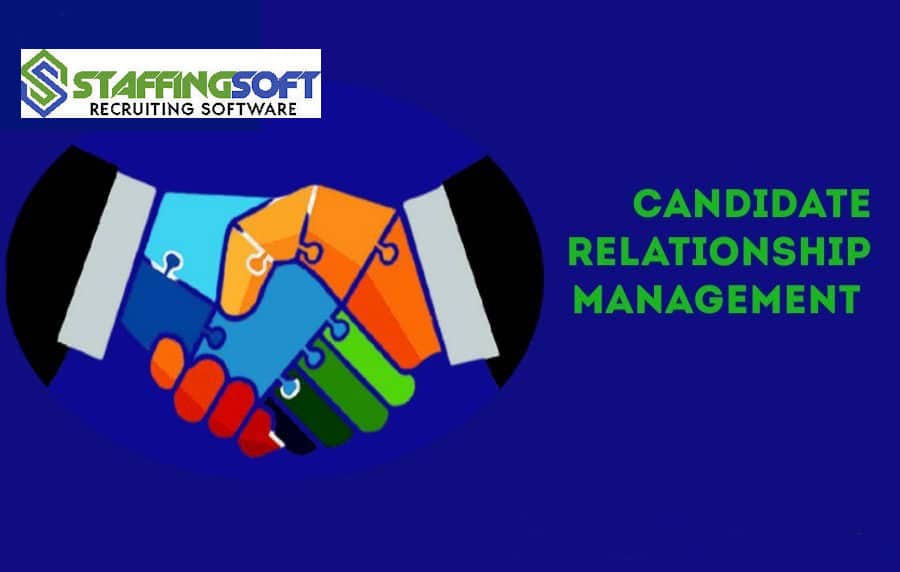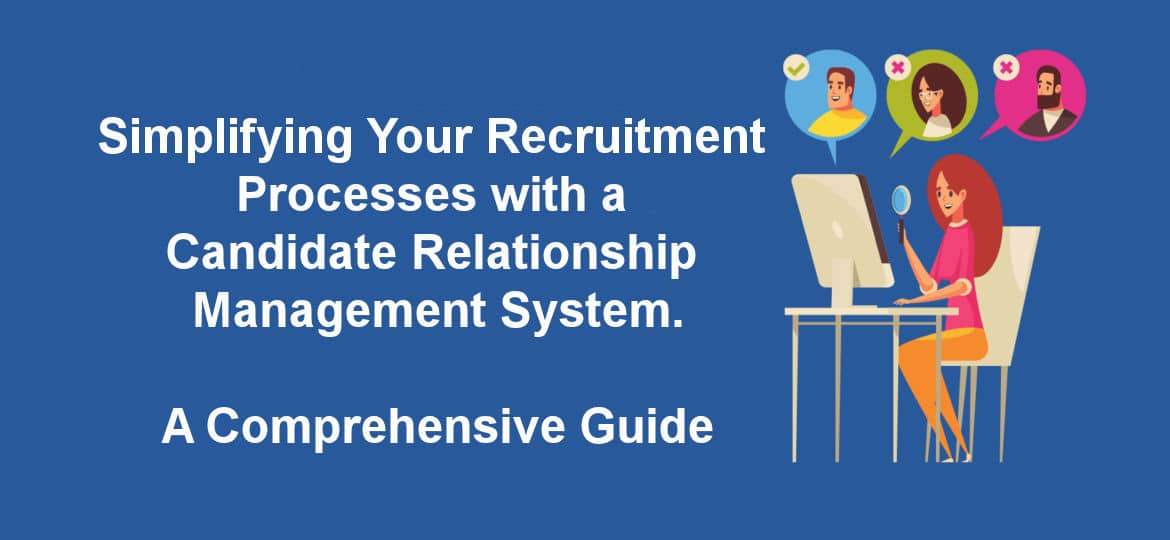Efficiency in the hiring process is crucial for businesses competing in today’s job market. In order to handle numerous applicants effectively, companies are embracing modern solutions like candidate relationship management (CRM) systems. In this detailed guide, we will delve into how integrating a CRM system can transform your recruitment procedures and assist you in identifying top notch candidates.
A candidate relationship management system serves as a valuable tool that enables recruiters to maintain and foster connections with potential candidates throughout the recruitment journey. Through functionalities such as applicant tracking, automated correspondence and centralized information, recruiters can enhance their workflows and make well informed hiring choices.
By utilizing a CRM system, you can craft a positive and interactive experience for candidates, enhance communication and teamwork among your recruitment team and ultimately make superior hires. Whether you operate a small business or a large corporation, this guide offers valuable insights and tactics to successfully incorporate a CRM system and enhance your recruitment processes.
Prepare to elevate your recruitment strategies with the capabilities of candidate relationship management. Let’s get started!
What exactly is a Candidate Relationship Management System (CRMS)?
A Candidate Relationship Management (CRM) system is a highly effective software tool crafted to streamline and enhance the recruitment process for companies of all sizes. Essentially, a CRMS serves as a central hub where recruiters and hiring teams can efficiently handle and nurture connections with potential candidates throughout the entire recruitment journey.
The primary role of a CRMS is to offer a comprehensive perspective on each candidate, starting from their initial application to the final hiring choice. By consolidating all candidate information, communication records and hiring activities within one system, CRMS enables recruiters to make more informed decisions, enhance candidate interaction and elevate the overall recruitment experience.
In contrast to traditional applicant tracking systems (ATS) that mainly concentrate on the administrative aspects of recruitment, a CRMS takes a more holistic approach. It not only oversees application processes but also empowers recruiters to establish and sustain long term relationships with candidates, including those who might not be suitable for current openings. This proactive strategy assists organizations in building a strong talent pool and gaining an edge in attracting top talent.

Improving Hiring Efficiency – Staffing Software
The advantages of utilizing a CRMS in recruitment procedures
Integrating a Candidate Relationship Management System can yield numerous advantages for your recruitment operations.
One of the most significant advantages is that you can make your recruitment tasks more efficient and automated, allowing your team to focus on important strategic activities. By keeping all candidate information and communication in one place using a CRMS, you can get rid of manual data entry, document handling and email tracking. This not only saves time and reduces the chance of errors but also ensures that your team always has access to accurate and current information. This, in turn, can help speed up decision making and improve your hiring processes.
Another great thing about using a CRMS is the improved experience it offers to candidates. Through features like automated messages, personalized outreach and self service tools, you can create a more interactive and clear process for applicants. This could result in higher satisfaction among candidates, increased completion rates for applications and a stronger employer brand that helps you attract and retain top talent.
Enhancing recruitment with a CRMS
A Candidate Relationship Management System has the potential to transform how you handle recruitment by simplifying various tasks through automation. One of the main ways a CRMS can streamline your hiring processes is through its effective applicant tracking features.
By using a CRMS, you can gather all job postings, applications and candidate details in one place. This eliminates the need for manual data entry and ensures your team has instant access to important information about each applicant. Furthermore, many CRMS solutions offer advanced search and filtering options, making it easier to pinpoint and evaluate the most qualified candidates for each position.
Another benefit of a CRMS is its automated communication tools. Instead of relying on manual emails or phone calls, a CRMS can be set up to send personalized updates to candidates throughout the hiring process. This not only enhances the candidate experience but also frees up your team’s time for more strategic activities.
Enhancing candidate experience is essential in today’s competitive job market and a Candidate Relationship Management System can greatly contribute to this effort. By utilizing the features of a CRMS, you can create a more interactive, transparent and tailored recruitment process for your applicants.
One key way that a CRMS enhances candidate experience is through its automated communication functionalities.
Instead of keeping candidates uninformed, a CRMS can be set up to send personalized updates and notifications at every step of the hiring process, ensuring they stay in the loop and engaged. This may involve acknowledging receipt of applications, providing status updates, setting up interviews and even giving feedback on their candidacy results.
Moreover, a CRMS often provides self service portals that enable candidates to monitor the status of their application, update their profiles and access resources such as job descriptions and company details. This level of openness and autonomy can significantly improve how candidates perceive the hiring process and their overall satisfaction with your company.

Important features to consider in a CRMS
When choosing a Candidate Relationship Management System for your company, it’s crucial to assess various features that can streamline your recruitment procedures and enhance the candidate experience. Here are some key attributes to seek in a CRMS;
Comprehensive applicant tracking; A robust CRMS should offer advanced applicant tracking functionalities, including posting job openings, managing applications and monitoring each candidate’s progress through the recruitment process.
Automated communication; It’s crucial for CRMS solutions to have automated communication capabilities, like customized email templates, SMS integration and automated interview scheduling. These features improve the candidate experience and lighten the workload for your team.
Candidate database and talent pipeline management; A good CRMS acts as a central repository for all candidate information, enabling you to build and maintain a strong talent pool. It should include tools for candidate profiles, resume analysis and advanced search functions.
Reporting and analytics; Seek out a CRMS with robust reporting and analytics features that allow you to monitor essential hiring metrics, pinpoint areas for enhancement and make informed decisions based on data.
Integration with other HR systems; Opt for a CRMS that seamlessly integrates with your current HR software such as applicant tracking systems, HR information systems (HRIS) and employee onboarding tools to enhance the efficiency of your recruitment processes.
By focusing on these essential elements, you can ensure that your investment in a CRMS aligns with your organization’s recruitment objectives and equips you with the tools needed to streamline hiring efforts.
Integrating a Candidate Relationship Management System into Your Hiring Process
Incorporating a Candidate Relationship Management System into your hiring workflow can be game changing but requires meticulous planning and flawless execution.
Here are the essential steps for smoothly incorporating a CRMS into your organization;
- Evaluate your current hiring needs and challenges; Start by thoroughly analyzing your existing hiring processes to identify areas that could benefit from a CRMS. This analysis will help you determine the specific features and functionalities you need.
- Gain support from key stakeholders; Get approval and support from your executive team, HR leaders and hiring managers. Show them how a CRMS can bring benefits and align with your organization’s strategic objectives.
- Define your requirements and criteria for selecting a CRMS; Create a detailed list of features, integrations and user experience requirements based on your assessment. This list will guide you in evaluating and choosing the right solution.
- Research and compare CRMS providers; Conduct thorough research on different CRMS vendors, considering aspects like functionality, scalability, ease of use, customer support and pricing before making a decision.
- Develop a detailed implementation plan; Once you’ve chosen a CRMS provider, collaborate with them to create an implementation plan that outlines timelines, responsibilities and training needs for a successful rollout.
Make sure your recruiting team, hiring managers and other involved parties undergo thorough training on the CRMS, understanding its functionalities and following best practices for effective utilization.
Continuously monitor and fine tune; Regularly assess your CRMS’s performance, gather user feedback and make necessary tweaks to ensure it aligns with your evolving recruitment requirements.
By adhering to these guidelines, you can smoothly incorporate a Candidate Relationship Management System into your hiring process and unleash its full potential in streamlining recruitment operations and enhancing candidate satisfaction.
Best practices for using a CRMS effectively
To fully leverage the benefits of a Candidate Relationship Management System, it’s essential to adopt best practices for using the system effectively. Here are some key strategies to consider:
- Maintain a clean and organized candidate database: Regularly review and update your CRMS database to ensure that all candidate information is accurate, up-to-date, and properly categorized. This will help you quickly identify and engage with the most relevant candidates.
- Automate communication and outreach: Maximize the use of automated communication features within your CRMS, such as personalized email templates, automated interview scheduling, and targeted candidate nurturing campaigns. This will help you maintain consistent and timely engagement with your applicants.
- Leverage data and analytics: Utilize the reporting and analytics capabilities of your CRMS to track key hiring metrics, identify areas for improvement, and make data-driven decisions. This can help you optimize your recruitment strategies and enhance the overall effectiveness of your hiring processes.
- Integrate the CRMS with other HR systems: Seamlessly integrate your CRMS with other HR tools, such as your applicant tracking system, HRIS, and employee onboarding software. This will create a more streamlined and efficient hiring workflow, reducing the need for manual data entry and ensuring a consistent candidate experience.
- Encourage cross-team collaboration: Promote collaboration between your recruitment team, hiring managers, and other stakeholders by providing them with access to the CRMS. This will foster better communication, shared visibility, and more informed decision-making throughout the hiring process.
- Continuously refine and optimize: Regularly review and refine your CRMS usage, gathering feedback from users and making adjustments as needed. This will help you adapt to changing hiring needs, identify new opportunities for improvement, and ensure that your CRMS remains a valuable asset for your organization.
By adopting these best practices, you can maximize the efficiency and effectiveness of your Candidate Relationship Management System, ultimately leading to better hiring outcomes and a more positive candidate experience.

Integrating a CRMS with other HR systems
Integrating a Candidate Relationship Management System (CRMS) with other HR systems can significantly enhance the efficiency and effectiveness of your hiring processes. By seamlessly connecting your CRMS with complementary HR tools, you can create a more streamlined and cohesive workflow, reducing the need for manual data entry and ensuring a consistent candidate experience.
One of the most crucial integrations for a CRMS is with your Applicant Tracking System (ATS). By connecting these two systems, you can automate the flow of candidate data, ensuring that all applicant information is accurately captured and readily available to your recruitment team. This integration can also enable features like automated job posting syndication, resume parsing, and candidate status updates, which can significantly streamline the application and screening process.
Another valuable integration is with your Human Resource Information System (HRIS). By connecting your CRMS with your HRIS, you can create a more seamless onboarding experience for new hires, as well as maintain a comprehensive view of employee data and hiring history. This integration can also facilitate the transfer of candidate information to the HRIS, ensuring a smooth transition from the recruitment phase to the employee lifecycle.
Choosing the right CRMS for your organization
Selecting the right Candidate Relationship Management System (CRMS) for your organization is a critical decision that can have a significant impact on the efficiency and effectiveness of your hiring processes. With a wide range of CRMS solutions available in the market, it’s essential to carefully evaluate your specific needs and requirements to ensure that you choose the right fit for your business.
When evaluating CRMS options, consider the following key factors:
- Functionality and features: Assess the core capabilities of the CRMS, such as applicant tracking, automated communication, candidate database management, and reporting and analytics. Ensure that the solution aligns with your current and future hiring needs.
- Scalability and flexibility: Look for a CRMS that can grow with your organization, accommodating changes in your hiring volume, team size, and recruitment strategies. The solution should also offer the flexibility to customize and adapt to your unique workflows.
- Ease of use and user experience: Evaluate the user interface and overall usability of the CRMS, ensuring that it is intuitive and easy for your recruitment team to navigate. This will encourage widespread adoption and maximize the benefits of the system.
- Integration capabilities: Assess the CRMS’s ability to seamlessly integrate with your existing HR systems, such as your ATS, HRIS, and employee onboarding tools. This will help create a more cohesive and efficient hiring ecosystem.
- Customer support and implementation: Consider the level of support and guidance provided by the CRMS vendor, both during the implementation phase and throughout the ongoing use of the system. A reliable and responsive partner can significantly contribute to the success of your CRMS deployment.
- Pricing and cost of ownership: Evaluate the pricing structure of the CRMS, including any upfront costs, subscription fees, and hidden charges. Ensure that the solution fits within your budget and provides a strong return on investment.
By carefully considering these factors and aligning the CRMS selection with your organization’s specific hiring needs and goals, you can ensure that you choose the right solution to streamline your recruitment processes and enhance the candidate experience.

Conclusion: The future of hiring with CRMS
As the job market continues to evolve and the competition for top talent intensifies, the role of Candidate Relationship Management Systems (CRMS) in shaping the future of hiring becomes increasingly crucial. These innovative platforms are poised to revolutionize the way organizations approach recruitment, offering a comprehensive and strategic approach to talent acquisition.
The integration of CRMS into hiring processes has already demonstrated remarkable benefits, including increased efficiency, improved candidate experience, and enhanced data-driven decision-making. As these systems continue to evolve, we can expect to see even more advanced features and capabilities that will further transform the hiring landscape.
For example, the integration of artificial intelligence and machine learning into CRMS can automate and streamline various recruitment tasks, such as resume screening, candidate matching, and personalized outreach. This not only frees up valuable time for recruiters but also helps to reduce bias and ensure a more equitable and inclusive hiring process.
Furthermore, the ability of CRMS to build and maintain robust talent pipelines will become increasingly important as organizations strive to stay ahead of the competition. By nurturing relationships with potential candidates, even those who may not be the right fit for a current opening, CRMS can help organizations build a diverse and qualified pool of talent, ready to be tapped into as future needs arise.
As we look to the future, it’s clear that Candidate Relationship Management Systems will play a pivotal role in shaping the hiring strategies of successful organizations. By embracing the power of these innovative tools, businesses can streamline their recruitment processes, enhance the candidate experience, and ultimately, make better hires that drive their organization’s growth and success.


